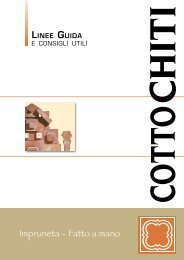Download - Cotto Chiti
Download - Cotto Chiti
Download - Cotto Chiti
Create successful ePaper yourself
Turn your PDF publications into a flip-book with our unique Google optimized e-Paper software.
6<br />
The clay<br />
The Impruneta quarries yield special<br />
clays, schists and marls which,<br />
when exposed to atmospheric<br />
agents for a certain time, become<br />
a paste that is so ductile it can be<br />
used to make even the largest and<br />
most ornate terra-cotta items.<br />
The blending<br />
The blending<br />
process consists of vigorously<br />
mixing the wet clay until it<br />
becomes a compact amalgamate<br />
without any air bubbles that could<br />
cause the piece to break while<br />
it is being fired.<br />
Quadro or square work<br />
Tondo or round work<br />
Differently sized and shaped frames<br />
are used to prepare<br />
the materials for walls and flooring.<br />
The frame is placed<br />
on a flat surface and the blended<br />
clay is poured onto it with force,<br />
and then it is pressed down<br />
and smoothed by hand.<br />
For decorative items the process<br />
is somewhat different. Clay “lucignoli”<br />
are made in various lengths,<br />
but they are always<br />
as thick as the sides of the vase.<br />
The “lucignoli” are placed over<br />
each other, and are pressed by<br />
hand, inside and out, molding<br />
them at the same time.<br />
The molding technique<br />
The tradition is also perpetuated<br />
in the old molding techniques<br />
with sectional molds. The clay is<br />
firmly pressed against the inside of<br />
l’argilla<br />
Dalle cave dell'Impruneta si estraggono<br />
particolari argille, scisti galestrini,<br />
le quali, esposte per qualche<br />
tempo all'azione degli agenti atmosferici,<br />
si riducono in una pasta<br />
tanto duttile da poterla utilizzare<br />
per la fabbricazione dei più grandi<br />
e ornati lavori in terracotta.<br />
l’impastatura<br />
L'impastatura consiste nel mescolare<br />
vigorosamente l'argilla bagnata<br />
tanto da farne un amalgama compatta<br />
e senza quelle bolle d'aria che<br />
al momento della cottura potrebbero<br />
provocare la rottura del pezzo.<br />
Il lavoro quadro<br />
Il lavoro tondo<br />
Per la preparazione del materiale<br />
murario e per la pavimentazione<br />
si predispongono dei telai di varia<br />
forma e misura. Nel telaio posato<br />
su un piano viene gettata con forza<br />
l'argilla impastata, pressata con le<br />
mani e lisciata. Per la creazione dei<br />
decori si preparano dei "lucignoli"<br />
di argilla più o meno lunghi<br />
e di uno spessore uguale a quello<br />
previsto per le pareti del vaso. I<br />
"lucignoli" si sovrappongono e si<br />
saldano via via pressando con le<br />
mani sia all'interno che all'esterno<br />
e modellando nello stesso tempo.



